Maintaining clean and healthy environments, whether at home or in a business, requires more than just wiping away visible dirt. True surface hygiene involves controlling the presence of microscopic organisms – bacteria, viruses, and fungi – that can cause illness.
I. Understanding Surface Hygiene: Cleaning, Sanitizing, and Disinfecting
The terms “cleaning,” “sanitizing,” and “disinfecting” are often used interchangeably, but they represent distinct processes with different outcomes. Understanding this hierarchy is fundamental to achieving the desired level of surface hygiene.
Contact us!
A. Defining the Terms: What Each Process Achieves
- Cleaning: This is the essential first step in any surface hygiene protocol. Cleaning involves the physical removal of dirt, debris, food particles, organic matter (like body fluids), and some germs from surfaces. It typically utilizes water combined with soaps or detergents and physical scrubbing. The primary action of cleaning is removal, not killing. While cleaning significantly lowers the number of germs on a surface and reduces risks, it does not eliminate all harmful pathogens. Its importance cannot be overstated, as the presence of dirt and organic material can physically shield microbes and chemically interfere with the action of sanitizers and disinfectants.
- Sanitizing: Sanitizing lowers the number of bacteria on a surface to a level considered safe according to public health standards or requirements. This reduction can be achieved through effective cleaning or by applying a chemical sanitizer. EPA-registered chemical sanitizers are specifically formulated and tested to reduce bacteria, but they are generally not designed or tested to kill viruses. Sanitizing is particularly relevant for surfaces that come into contact with food or items that children might put in their mouths, like toys.
- Disinfecting: This process uses chemical products (disinfectants) to kill or inactivate a much broader range of harmful microorganisms on inanimate surfaces, including specific bacteria and viruses, and sometimes fungi. The goal of disinfection is to kill pathogens remaining after cleaning, thereby further lowering the risk of spreading infection. Unlike cleaning, disinfection focuses on killing germs rather than physically removing them, although many disinfectant products also contain cleaning agents.
- Sterilizing: Representing the highest level of microbial control, sterilization is a process that destroys or eliminates all forms of microbial life, including highly resistant bacterial spores. This level of decontamination is typically reserved for critical applications, primarily in healthcare settings (e.g., surgical instruments) and laboratories, using methods like pressurized steam, dry heat, specific gases (like ethylene oxide), or chemical sterilants. Sterilization is generally beyond the scope and necessity of routine environmental cleaning services.
The distinct purposes and outcomes of cleaning, sanitizing, and disinfecting form a clear hierarchy. Cleaning provides the necessary foundation by removing physical impediments. Sanitizing offers a reduction in bacterial load, crucial for specific applications like food safety. Disinfecting targets a broader spectrum of pathogens, including viruses, aiming to prevent disease transmission.
Applying these processes correctly, in the right sequence, and in the appropriate context is vital. Using a sanitizer when disinfection against viruses is required, or attempting to disinfect a visibly dirty surface without prior cleaning, will lead to ineffective results and potentially compromise health and safety.

B. The Critical Difference: Performance Standards and Pathogen Targets
The distinction between sanitizers and disinfectants is formally defined by regulatory performance standards, primarily focusing on the required level of microbial kill (often expressed as log reduction) and the types of microorganisms targeted.
- Kill Percentages (Log Reduction): Regulatory agencies like the EPA quantify product efficacy using a logarithmic scale. A “log reduction” indicates a 10-fold (or 90%) reduction in microbes.
- Sanitizers (Non-Food Contact Surfaces): Generally required to achieve a 99.9% (3-log) reduction of specific test bacteria within a set time (e.g., 5 minutes).
- Sanitizers (Food Contact Surfaces): Must meet a more stringent standard: a 99.999% (5-log) reduction of specific test bacteria, typically Escherichia coli and Staphylococcus aureus, within 30 seconds under specified test conditions. These products are often formulated for use without requiring a water rinse afterwards.
- Disinfectants: Must meet an even higher efficacy standard. They typically need to demonstrate a 99.9999% (6-log) reduction against specific test bacteria (Staphylococcus aureus and Pseudomonas aeruginosa for hospital-grade claims). Furthermore, disinfectants must prove efficacy against other specific pathogens listed on their label, which often include viruses and sometimes fungi, usually requiring longer contact times (e.g., 10 minutes) than sanitizers. While some sources may cite a 5-log (99.999%) kill for disinfectants , the key takeaway is that they must meet a significantly higher bar for microbial inactivation than sanitizers.
- Pathogen Spectrum: This is a fundamental differentiator. Sanitizers are primarily evaluated for their effectiveness against bacteria. Disinfectants, however, are designed and tested to kill a broader spectrum of microorganisms, including specific bacteria, viruses, and potentially fungi, as indicated on the product label. Products making specific claims like “virucidal” or “fungicidal” have undergone testing to prove effectiveness against those particular types of microbes.
The term “sanitizer” itself carries different performance expectations depending on the intended use. The 5-log reduction standard for food-contact surfaces is significantly higher than the 3-log standard for non-food contact surfaces. úThis variability underscores that product selection cannot be based on terminology alone; it demands careful consideration of the specific application context and the associated regulatory requirements (e.g., EPA for general surfaces, FDA oversight for food-contact suitability ). This complexity highlights the importance of understanding label details and the potential pitfalls of misapplication.
C. Why Cleaning First Matters: The Impact of Organic Load
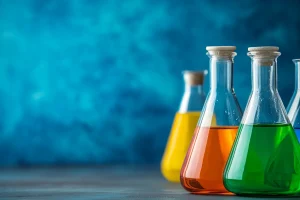 Thorough cleaning before applying sanitizers or disinfectants is not merely a suggestion; it is a prerequisite for effectiveness. The presence of organic matter – such as dirt, dust, blood, bodily fluids, food particles, or biofilms – significantly compromises the performance of antimicrobial chemicals in several ways:
Thorough cleaning before applying sanitizers or disinfectants is not merely a suggestion; it is a prerequisite for effectiveness. The presence of organic matter – such as dirt, dust, blood, bodily fluids, food particles, or biofilms – significantly compromises the performance of antimicrobial chemicals in several ways:
- Physical Barrier: Dirt and organic debris can physically cover microorganisms, preventing the sanitizer or disinfectant from reaching and acting upon them. Clumped or aggregated microbes are also inherently harder to inactivate.
- Chemical Interference: Many disinfectant active ingredients react with organic matter. This reaction can consume the active ingredient, reducing the concentration available to kill microbes, or chemically neutralize the disinfectant altogether. Bleach (sodium hypochlorite), hydrogen peroxide, quaternary ammonium compounds (Quats), and phenolic compounds are all susceptible to reduced efficacy in the presence of organic soil.
Therefore, attempting to sanitize or disinfect a surface that has not been adequately cleaned is likely to be ineffective, wasting product and time, and failing to achieve the necessary reduction in microbial load. Cleaning removes the interfering substances, allowing the antimicrobial agent to work as intended.
II. Decoding the Label: EPA Registration and Safe Use
The label on a disinfectant or sanitizer product is more than just a set of instructions; it is a regulatory document packed with critical information about the product’s proven efficacy, proper usage, and safety requirements. Understanding how to read and interpret this label is essential for effective and safe application.
A. The Role of the EPA: Ensuring Effectiveness and Safety
In the United States, chemical products intended to kill microbes on environmental surfaces (sanitizers and disinfectants) are regulated by the Environmental Protection Agency (EPA) under the Federal Insecticide, Fungicide, and Rodenticide Act (FIFRA), classifying them as antimicrobial pesticides. (Note: Hand sanitizers intended for use on skin are regulated by the Food and Drug Administration, FDA ).
The presence of an EPA Registration Number (EPA Reg. No.) on a product label signifies that:
- The product has undergone rigorous testing according to standardized EPA protocols.
- The EPA has reviewed scientific data submitted by the manufacturer to validate the product’s efficacy claims against the specific microorganisms listed on the label (e.g., specific bacteria, viruses, fungi).
- The EPA has reviewed data regarding the product’s potential effects on human health and the environment and determined that, when used according to label directions, it will not cause unreasonable adverse effects.
This registration process ensures a baseline level of confidence in the product’s performance. The EPA maintains specific lists of registered products proven effective against pathogens of public health concern, such as List N for disinfectants effective against SARS-CoV-2 (the virus causing COVID-19) and List B for products effective against Mycobacterium tuberculosis. Furthermore, EPA registration is mandatory before these products can be legally imported, sold, or distributed within the U.S..
Additionally, programs like the EPA’s Design for the Environment (DfE) help identify antimicrobial products that meet EPA registration standards while also containing ingredients deemed safer for human health and the environment.
B. Reading the Fine Print: Why Label Directions are Non-Negotiable
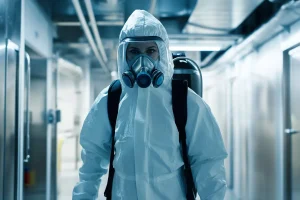 The EPA-approved label provides legally binding instructions for use. Adhering strictly to these directions is paramount for achieving the claimed level of microbial kill and for ensuring user safety. Deviating from the label instructions – whether by using the wrong dilution, shortening the contact time, or applying it to an inappropriate surface – can render the product ineffective and potentially hazardous.
The EPA-approved label provides legally binding instructions for use. Adhering strictly to these directions is paramount for achieving the claimed level of microbial kill and for ensuring user safety. Deviating from the label instructions – whether by using the wrong dilution, shortening the contact time, or applying it to an inappropriate surface – can render the product ineffective and potentially hazardous.
Key information found on the label includes :
- EPA Registration Number: Confirms EPA review and registration.
- Active Ingredients: Lists the chemicals responsible for the antimicrobial action.
- Target Microorganisms: Specifies the bacteria, viruses, and fungi the product is proven effective against when used as directed.
- Approved Surfaces/Sites: Indicates where the product can be safely and effectively used (e.g., hard non-porous surfaces, specific materials) and surfaces to avoid (due to potential damage like corrosion or discoloration).
- Contact Time (Dwell Time): This is one of the most critical parameters. It specifies the minimum amount of time the surface must remain visibly wet with the disinfectant or sanitizer solution to achieve the claimed efficacy against the target pathogens. Contact times can vary significantly between products and even for different microorganisms on the same label (e.g., a shorter time for common bacteria, a longer time for viruses or fungi). It is crucial not to wipe the surface dry before the contact time is complete, as this will halt the antimicrobial action. Achieving and maintaining the correct contact time, especially with products that evaporate quickly like alcohols, is essential for success. Failure to adhere to the specified contact time is a common reason for disinfection failure.
- Dilution Instructions: Clearly states whether the product is Ready-To-Use (RTU) or requires dilution from a concentrate. If dilution is required (e.g., for bleach concentrates), the label provides the precise ratio (e.g., ounces per gallon). Using the correct amount of product and water (usually room temperature unless specified otherwise) is vital; over-diluting makes the product too weak, while under-diluting (making it too strong) can damage surfaces, increase hazards, and may not improve efficacy. Diluted solutions should be properly labeled.
- Application Method: Specifies how to apply the product (e.g., spray, wipe, mop, immersion). The EPA generally does not evaluate or recommend application methods like fogging, misting, or electrostatic spraying unless the product label specifically includes directions for these uses, as safety and efficacy under those conditions may not have been assessed.
- Safety Precautions: Outlines necessary Personal Protective Equipment (PPE), such as specific types of gloves (nitrile or rubber are often recommended over latex for chemical resistance), eye protection (goggles or face shields), and potentially respiratory protection. It also includes hazard statements (e.g., “Warning,” “Danger”) indicating the level of potential risk and requirements for adequate ventilation during use.
- Rinsing Requirements: Specifies if the surface needs to be rinsed with potable (drinking quality) water after the contact time has elapsed. Rinsing is often required for surfaces that will come into contact with food, unless the product is specifically labeled as a “no-rinse” food-contact sanitizer. Rinsing may also be recommended for other surfaces to remove residue.
- First Aid and Storage/Disposal: Provides instructions for accidental exposure and proper storage and disposal guidelines.
For more detailed chemical hazard information, handling procedures, and emergency measures, a Safety Data Sheet (SDS) should be available from the manufacturer or supplier. Employers are required by the Occupational Safety and Health Administration (OSHA) to maintain SDSs for hazardous chemicals and provide employee training on their safe use.
The rigorous testing, regulatory oversight, and detailed instructions encapsulated in the product label underscore its importance. It is not merely guidance but a reflection of scientific validation and legal compliance. Treating the label with this level of seriousness – ensuring precise adherence to dilution, contact time, application method, and safety precautions – is fundamental to effective disinfection and is a hallmark of professional cleaning practices.
III. A Closer Look: Common Disinfectant & Sanitizer Chemistries
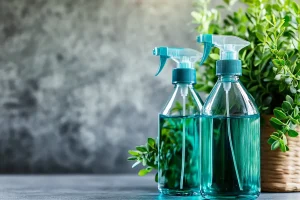 A wide array of chemical active ingredients are used in sanitizers and disinfectants. Understanding the properties, strengths, and weaknesses of common chemical classes helps in selecting the most appropriate product for a given task, considering factors like the target microorganisms, the type of surface, required contact time, safety profile, environmental impact, and cost. No single chemical is perfect for all situations; selection always involves balancing these factors.
A wide array of chemical active ingredients are used in sanitizers and disinfectants. Understanding the properties, strengths, and weaknesses of common chemical classes helps in selecting the most appropriate product for a given task, considering factors like the target microorganisms, the type of surface, required contact time, safety profile, environmental impact, and cost. No single chemical is perfect for all situations; selection always involves balancing these factors.
A. Quaternary Ammonium Compounds (Quats)
- Examples: Benzalkonium chloride (BAC), Alkyl dimethyl benzyl ammonium chloride (ADBAC), Didecyl dimethyl ammonium chloride (DDAC).
- Mechanism: These positively charged molecules disrupt the negatively charged cell membranes of microbes and interfere with key proteins.
- Characteristics: Quats are broad-spectrum cationic detergents effective against most vegetative bacteria (Gram-positive and Gram-negative), fungi, and enveloped viruses (like influenza, herpes, HIV). However, they are generally not effective against bacterial spores, non-enveloped viruses (like Norovirus), or Mycobacterium tuberculosis. They are considered low-level disinfectants. Many formulations include detergents, providing good cleaning ability alongside disinfection. They are relatively stable, often colorless and odorless, generally non-staining, and less corrosive than bleach.
- Pros: Widely used due to their effectiveness against common pathogens, good cleaning properties, relatively low cost, good material compatibility (don’t typically damage fabrics or common surfaces), and ease of use.
- Cons: Efficacy can be reduced by hard water and anionic residues from soaps or detergents. A significant issue is “quat binding,” where the positively charged Quat molecules bind strongly to negatively charged materials like cotton or cellulose fibers in cleaning cloths, reducing the amount of active ingredient actually reaching the surface. This necessitates using synthetic microfiber, non-woven, or disposable cloths for application. There are also growing concerns regarding their environmental impact (toxicity to aquatic organisms), potential contribution to antimicrobial resistance in bacteria, and potential links to human health issues like respiratory irritation, skin sensitization, and possible reproductive/developmental effects, though more research is ongoing. Skin and eye irritation can occur.
B. Alcohols (Ethanol, Isopropanol)
- Concentration: Optimal germicidal efficacy is typically achieved at concentrations between 60% and 90% in water. Water is essential for the mechanism of action, so absolute (100%) alcohol is less effective.
- Mechanism: Denature essential proteins within microbial cells.
- Characteristics: Alcohols provide rapid and broad-spectrum activity against vegetative bacteria (including Mycobacterium tuberculosis), fungi, and enveloped viruses (e.g., influenza, herpes, coronaviruses, HIV, HBV, HCV). Their effectiveness against non-enveloped viruses is variable; ethanol generally has better activity than isopropanol against some (like rotavirus), but neither is reliably effective against others like poliovirus or hepatitis A virus. Alcohols are not effective against bacterial spores.
- Pros: Very fast-acting, kill a wide range of common pathogens including TB, evaporate quickly without leaving a residue.
- Cons: Highly flammable, posing a fire hazard requiring careful storage and use away from ignition sources. Rapid evaporation makes achieving the necessary contact time difficult, especially on larger surfaces, limiting their suitability for broad surface disinfection. They have poor cleaning ability (do not remove soil) and can be inactivated by organic matter. Repeated use can damage certain materials, including shellac coatings, rubber, some plastics, and adhesives used in medical devices like tonometers. Can cause skin dryness and eye irritation.
C. Chlorine Compounds (Sodium Hypochlorite/Bleach)
- Mechanism: Primarily works through oxidation. When diluted in water, sodium hypochlorite forms hypochlorous acid (HOCl), a strong oxidizing agent that damages proteins, nucleic acids, and other essential components of microbial cells.
- Characteristics: Household bleach is typically a 5.25% to 6.15% solution of sodium hypochlorite (yielding 52,500–61,500 ppm available chlorine). It is a powerful, broad-spectrum germicide effective against bacteria, viruses (both enveloped and non-enveloped), fungi, and Mycobacterium tuberculosis (requires sufficient concentration and contact time). At higher concentrations (e.g., >1000 ppm, often achieved with a 1:50 dilution or stronger) and with adequate contact time, it is also sporicidal.
- Pros: Highly effective against a very broad range of pathogens, including difficult-to-kill organisms like non-enveloped viruses and spores (at appropriate concentrations); inexpensive and widely available; relatively fast-acting.
- Cons: Highly corrosive to metals and can damage or discolor fabrics. Efficacy is significantly reduced by the presence of organic matter (requiring thorough pre-cleaning) and by exposure to heat and light (diluted solutions lose strength over time and should be prepared fresh, typically daily). Has a strong, pungent odor and can irritate the skin, eyes, and respiratory tract, requiring good ventilation and appropriate PPE during use. Critically, bleach must never be mixed with ammonia or acidic cleaners, as this can release toxic chlorine gas. The chlorine residual in wastewater can be toxic to aquatic life. Some parasites like Cryptosporidium cysts show resistance to typical disinfection levels.
- Dilutions & Contact Time: Common dilutions for surface disinfection include 1:100 (approx. 500-615 ppm available chlorine) for general surfaces and 1:10 (approx. 5000-6150 ppm) for decontaminating blood spills. A 1:500 dilution (>100 ppm) may suffice for low-level disinfection. Contact times are typically 10 minutes or longer, depending on the target pathogen and concentration.
D. Hydrogen Peroxide (H2O2)
- Mechanism: A strong oxidizing agent that works by producing hydroxyl free radicals (∙OH), which are highly reactive and damage essential cell components like lipids, proteins, and DNA.
- Characteristics: Broad-spectrum activity against bacteria, viruses, fungi, and yeasts. Higher concentrations (e.g., 6% to 25%) and longer contact times are required for sporicidal activity. A key advantage is that it breaks down into environmentally benign water and oxygen.
- Pros: Decomposition products (water, oxygen) are non-toxic, making it more environmentally friendly than some other disinfectants. Less irritating than bleach and does not produce noxious fumes (though concentrated vapors can be irritating). Effective against some harder-to-kill pathogens like Cryptosporidium. May help lift organic soil.
- Cons: Standard hydrogen peroxide solutions (like the common 3% household strength) can be relatively slow-acting and less potent than other disinfectants. Stability is a concern; H2O2 decomposes upon exposure to light, heat, or certain contaminants. Efficacy is reduced by organic matter, necessitating thorough cleaning first. Higher concentrations needed for robust disinfection (e.g., 7.5% used in some healthcare disinfectants) can be corrosive to certain metals like copper, brass, and zinc, and pose significant safety hazards (severe skin burns, eye damage, respiratory irritation). Concentrated H2O2 is a strong oxidizer and can potentially cause combustion if contacted with organic materials.
E. Accelerated Hydrogen Peroxide (AHP)
- Mechanism: AHP formulations enhance the germicidal power of hydrogen peroxide by combining it with a synergistic blend of ingredients, typically including surfactants (soaps/detergents), wetting agents (to help spread and penetrate), and chelating agents (to counteract water hardness). These additives stabilize the H2O2 and accelerate its germicidal activity.
- Characteristics: AHP products are designed to overcome some limitations of standard hydrogen peroxide. They offer broad-spectrum efficacy with significantly faster kill times, often combining cleaning and disinfection in one step. They maintain the favorable environmental profile of H2O2, decomposing into water and oxygen.
- Pros: Faster disinfectant action and better cleaning performance compared to standard H2O2; enhanced stability; generally excellent material compatibility; favorable safety profile with low volatility, often low irritation potential, and no noxious fumes or VOCs; effective against biofilms; environmentally friendly decomposition.
- Cons: As proprietary formulations, AHP products are typically more expensive than basic commodity chemicals like bleach or standard hydrogen peroxide.
F. Phenolic Compounds
- Mechanism: Act as broad “protoplasmic poisons,” disrupting microbial cell walls and membranes, precipitating essential proteins, and inactivating critical enzyme systems.
- Characteristics: Phenolics offer broad-spectrum efficacy, killing vegetative bacteria (including Mycobacterium tuberculosis), fungi, and enveloped viruses. They are generally not effective against non-enveloped viruses or bacterial spores. They were historically used widely in hospitals and laboratories.
- Pros: Maintain activity in the presence of hard water and some organic matter (though heavy soil still reduces efficacy); can leave a residual antimicrobial film; some formulations have anti-rusting properties.
- Cons: Have a characteristic strong, unpleasant odor; can be corrosive and cause skin and eye irritation; potential for systemic toxicity with excessive exposure. Can leave a residue that may be irritating or damage certain surfaces over time. Due to toxicity concerns and environmental persistence, their use has declined significantly, especially in consumer products, and OSHA regulates workplace exposure. Disposal may be restricted in some areas. Effectiveness is reduced by highly alkaline conditions and soaps.
G. Iodophors (Iodine complexes)
- Mechanism: Iodophors are complexes of elemental iodine with a solubilizing agent or carrier (like povidone), which releases free iodine gradually. The free iodine penetrates microbial cells and interferes with protein synthesis and damages cell membranes by binding to essential cellular components.
- Characteristics: Provide broad-spectrum activity against bacteria, viruses, fungi, and Mycobacterium tuberculosis (requires adequate contact time). Some sporicidal activity is possible, but typically requires high concentrations and long exposure. Commonly used as antiseptics (on skin) and disinfectants (on surfaces) in healthcare and sometimes food service.
- Pros: Less irritating and less likely to stain than tinctures of pure iodine; retain effectiveness in the presence of hard water; rapid antimicrobial action; relatively low tissue toxicity compared to iodine alone. Can be used on food preparation surfaces.
- Cons: Can still stain fabrics and some surfaces, particularly plastics. Can be corrosive to metals over time. Have a characteristic odor. Effectiveness can be reduced by organic matter and certain inorganic substances. Proper dilution is critical for optimal efficacy and safety. Generally more expensive than bleach. It is crucial to use products EPA-registered for surface disinfection, not those intended solely as skin antiseptics.
H. Peracetic Acid (PAA)
- Mechanism: Also known as peroxyacetic acid, PAA is an extremely potent oxidizing agent, even stronger than chlorine. It rapidly disrupts cell membranes and denatures proteins and enzymes within microorganisms.
- Characteristics: PAA offers a very broad spectrum of activity, effective against bacteria, fungi, viruses, Mycobacterium tuberculosis, and bacterial spores, even at low temperatures. It is often formulated in equilibrium with hydrogen peroxide and acetic acid. Widely used in food processing (sanitizing equipment, washing fruits/vegetables), healthcare (sterilizing heat-sensitive medical devices in specialized automated systems), and water treatment.
- Pros: Highly effective, rapid action against all types of microorganisms, including spores; remains effective in the presence of organic matter; breaks down into harmless byproducts (acetic acid, water, oxygen), leaving no toxic residues; effective in cold water; excellent for removing biofilms. Does not coagulate blood or fix tissues to surfaces.
- Cons: Concentrated PAA solutions are highly corrosive to many metals (especially copper, brass, bronze, iron) and can damage some plastics. Solutions can be unstable, particularly when diluted. Has a strong, pungent, vinegar-like odor. Poses significant safety risks in concentrated form, causing severe irritation or burns to skin, eyes, and the respiratory tract. Generally more expensive than commodity disinfectants like bleach.
I. Aldehydes (Glutaraldehyde, Ortho-phthalaldehyde – OPA)
- Mechanism: Aldehydes work by alkylation, a chemical process that damages proteins and nucleic acids within microbial cells. Glutaraldehyde also causes coagulation of cellular proteins.
- Characteristics: These are high-level disinfectants (HLDs) and chemical sterilants capable of killing all forms of microbial life, including bacteria, viruses, fungi, mycobacteria, and bacterial spores, though sporicidal action requires extended contact times (hours). Their primary application is in healthcare for sterilizing or high-level disinfecting heat-sensitive reusable medical devices, such as endoscopes and surgical instruments. They are generally not used for routine environmental surface disinfection due to safety concerns and cost.
- Glutaraldehyde:
- Pros: Long history of use, excellent compatibility with most medical device materials, relatively inexpensive compared to other HLDs.
- Cons: Requires activation (typically by adding an alkaline buffer); relatively slow acting against mycobacteria and spores; pungent, highly irritating odor; potent respiratory irritant known to cause occupational asthma and other respiratory problems; skin irritant and sensitizer; fixes blood and proteins to surfaces, making cleaning prior to disinfection absolutely critical; requires immersion, excellent ventilation (fume hoods often recommended), strict adherence to safety protocols (gloves, eye protection), and potentially vapor monitoring; disposal may be regulated.
- Ortho-phthalaldehyde (OPA):
- Pros: Faster acting than glutaraldehyde for high-level disinfection (e.g., 12 minutes vs. 20-90 minutes); does not require activation; less odor and lower vapor pressure, reducing inhalation risk compared to glutaraldehyde; excellent material compatibility claimed.
- Cons: Significantly more expensive than glutaraldehyde; stains proteins gray or black, including skin, mucous membranes, clothing, and environmental surfaces; eye irritant upon contact; slow sporicidal activity (not typically used as a sterilant); reports of anaphylactic reactions in patients exposed via improperly rinsed medical devices, particularly those with a history of bladder cancer; potential for occupational sensitization. Requires similar careful handling and PPE as glutaraldehyde.
The diverse nature of these chemical agents highlights that disinfectant selection is a complex task. Factors like the required level of microbial kill, the types of surfaces being treated, potential compatibility issues, user safety, environmental considerations, contact time constraints, and cost must all be weighed. There is rarely a single “best” choice, but rather the most appropriate choice for a specific scenario. This decision-making process benefits significantly from professional knowledge and experience.
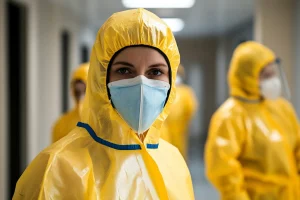 Furthermore, the field is dynamic, with ongoing research into the safety and efficacy of existing chemicals (like Quats) and the development of newer alternatives (like AHP or other chemistries like thymol or citric acid ) aiming to improve safety or environmental profiles.
Furthermore, the field is dynamic, with ongoing research into the safety and efficacy of existing chemicals (like Quats) and the development of newer alternatives (like AHP or other chemistries like thymol or citric acid ) aiming to improve safety or environmental profiles.
Staying abreast of these developments is crucial for responsible disinfection practices. It’s also important to recognize that the effectiveness of an active ingredient is influenced by the overall product formulation, including detergents, stabilizers, and pH buffers, meaning performance can vary even among products with the same active ingredient.
J. Comparison of Common Disinfectant Chemistries
The following table provides a simplified overview comparing key characteristics of the major disinfectant classes discussed:
| Active Ingredient Class | Common Examples | Key Mechanism | Spectrum Highlights | Common Uses | Key Pros | Key Cons |
|---|---|---|---|---|---|---|
| Quaternary Ammonium Compounds (Quats) | BAC, ADBAC, DDAC | Membrane disruption | Bacteria, Enveloped Viruses, Fungi (Not Spores, TB) | General surface disinfection, Food-contact sanitizing (specific formulas) | Good cleaning, Low cost, Non-staining, Good material compatibility | Reduced by soil/soap, Quat binding, Resistance/Health/Enviro concerns |
| Alcohols | Ethanol, Isopropanol (60-90%) | Protein denaturation | Bacteria, TB, Fungi, Enveloped Viruses (Variable non-enveloped, No Spores) | Small surface disinfection, Skin antisepsis | Fast acting, No residue | Flammable, Rapid evaporation (contact time issues), Poor cleaning, Damages some materials |
| Chlorine Compounds | Sodium Hypochlorite (Bleach) | Oxidation | Bacteria, Viruses, Fungi, TB, Spores (high conc.) | Surface disinfection, Water treatment, Laundry | Very broad spectrum, Inexpensive, Fast | Corrosive, Damages fabrics, Reduced by soil/light, Irritant/Odor, Hazardous mixing potential |
| Hydrogen Peroxide (H2O2) | 3% (household), 6-25% (professional) | Oxidation | Bacteria, Viruses, Fungi, Spores (high conc.) | Surface disinfection, Wound care (low conc.), Sterilization (high conc.) | Benign breakdown (H2O, O2), Less irritating than bleach | Standard form slow/unstable, Reduced by soil, Corrosive (high conc.), Safety hazards (high conc.) |
| Accelerated H2O2 (AHP) | Proprietary blends | Enhanced Oxidation | Bacteria, Viruses, Fungi, TB, Spores (variable) | Healthcare surfaces, General disinfection | Fast, Cleans well, Stable, Safe profile, Benign breakdown | Higher cost, Proprietary |
| Phenolic Compounds | o-Phenylphenol | Cell wall/Protein disruption | Bacteria, TB, Fungi, Enveloped Viruses (Not Spores) | Healthcare/Lab surfaces (historical) | Residual activity, Works with soil/hard water | Strong odor, Irritant/Toxic, Residue, Enviro concerns, Largely phased out |
| Iodophors | Povidone-Iodine complexes | Iodine release, Protein disruption | Bacteria, Viruses, Fungi, TB (extended time), Some Spores | Surface disinfection, Skin antisepsis | Broad spectrum, Rapid, Less irritating than iodine, Works in hard water | Staining (plastics), Corrosive (metals), Odor, Reduced by soil, Cost |
| Peracetic Acid (PAA) | PAA/H2O2 mixtures | Strong Oxidation | Bacteria, Viruses, Fungi, TB, Spores | Food industry sanitation, Medical device sterilization | Very broad spectrum (incl. spores), Rapid, Works with soil/cold, No toxic residue | Corrosive (metals), Unstable (diluted), Pungent odor, Safety hazards (conc.) |
| Aldehydes | Glutaraldehyde, OPA | Alkylation | Bacteria, Viruses, Fungi, TB, Spores | High-level disinfection/Sterilization of medical devices | Excellent material compatibility (Glut.), Faster (OPA) | Healthcare use only. Significant health hazards (irritation, sensitization, asthma), Strict handling required, Slow (Glut.), Stains (OPA) |
Note: Spectrum, pros, and cons can vary based on specific formulation and concentration. Always consult the product label.
IV. Meeting the Standard: Disinfectants by Application
Beyond the chemical composition, disinfectants are often categorized by the specific performance standards they meet, which relate directly to their intended use environment and the types of microbial challenges expected. These standards reflect a risk-based approach, ensuring that products used in critical settings meet appropriately high levels of efficacy.
A. Hospital-Grade Disinfectants: Meeting Healthcare Needs
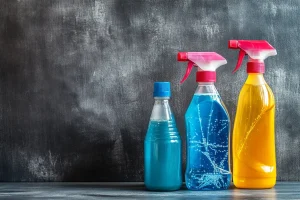 Disinfectants labeled as “Hospital Disinfectant” or “Hospital-Grade” have met specific EPA efficacy requirements designed for healthcare settings where the risk of pathogen transmission is elevated. To achieve this registration, a product must be tested using stringent Association of Official Analytical Chemists (AOAC) methods and proven effective against two key benchmark bacteria commonly associated with healthcare-associated infections (HAIs): Staphylococcus aureus (a Gram-positive bacterium) and Pseudomonas aeruginosa (a challenging Gram-negative bacterium).
Disinfectants labeled as “Hospital Disinfectant” or “Hospital-Grade” have met specific EPA efficacy requirements designed for healthcare settings where the risk of pathogen transmission is elevated. To achieve this registration, a product must be tested using stringent Association of Official Analytical Chemists (AOAC) methods and proven effective against two key benchmark bacteria commonly associated with healthcare-associated infections (HAIs): Staphylococcus aureus (a Gram-positive bacterium) and Pseudomonas aeruginosa (a challenging Gram-negative bacterium).
Meeting this standard provides assurance that the disinfectant possesses a baseline level of germicidal activity suitable for use on non-critical environmental surfaces (like bed rails, overbed tables, floors) in hospitals, clinics, dental offices, nursing homes, and other healthcare facilities. The EPA also implements post-market testing programs (such as the former Antimicrobial Testing Program (ATP) and the proposed Antimicrobial Performance Evaluation Program (APEP)) to help ensure that registered hospital disinfectants continue to meet efficacy standards once they are on the market.
B. Food-Contact Surface Sanitizers: Safety in Food Environments
Products intended for use on surfaces that directly touch food – such as countertops, cutting boards, utensils, and food processing equipment – fall under specific regulations to ensure food safety. An EPA-registered food-contact surface sanitizer must meet a demanding performance standard: it must kill 99.999% (a 5-log reduction) of specific test bacteria (Staphylococcus aureus and Escherichia coli) within 30 seconds under specified test conditions.
A critical feature of many products in this category is that they are formulated and approved for use without needing a subsequent rinse with potable water. This “no-rinse” characteristic is crucial in food preparation and processing environments to prevent chemical residues from contaminating food while ensuring microbial safety.
Common active ingredients found in food-contact sanitizers include Quats, chlorine (at appropriate low concentrations, typically 50-200 ppm available chlorine), iodophors, peracetic acid, and newer formulations based on alcohol, citric acid, or silver ions. It’s important to distinguish these from general-purpose disinfectants; if a disinfectant (not specifically approved as a no-rinse food-contact sanitizer) is used on a food-contact surface, a thorough potable water rinse is typically required after the contact time is met.
C. Tuberculocidal Disinfectants: The Intermediate Benchmark
A disinfectant that carries a “tuberculocidal” claim on its EPA-registered label has demonstrated effectiveness against Mycobacterium tuberculosis, the bacterium responsible for tuberculosis. The EPA maintains List B for these products. M. tuberculosis is chosen as a benchmark organism because it possesses a naturally waxy cell wall that makes it significantly more resistant to chemical disinfectants than most other vegetative bacteria, fungi, and lipid (enveloped) viruses.
While tuberculosis itself is primarily transmitted through the air, not via surfaces, the tuberculocidal claim serves as an indicator of a disinfectant’s potency. A product capable of killing M. tuberculosis is considered an intermediate-level disinfectant and is expected to be effective against a broad spectrum of less resistant pathogens.
This level of disinfection is often recommended for non-critical environmental surfaces in situations where contamination with more resistant organisms is suspected, or for specific protocols within healthcare settings. Chemicals capable of achieving tuberculocidal activity include certain phenolics, alcohols (70-90%), chlorine compounds (at sufficient concentration and contact time), iodophors (with extended contact time), glutaraldehyde, peracetic acid, and some hydrogen peroxide formulations.
D. Understanding Kill Claims: Bactericidal, Virucidal, Fungicidal, Sporicidal
Disinfectant labels often feature specific “kill claims” indicating the types of microorganisms the product is effective against. The suffix “-cidal” means the product kills the specified type of organism, whereas “-static” means it only inhibits growth.
- Bactericidal: Kills specified bacteria. (e.g., Staphylococcus aureus, Pseudomonas aeruginosa, Salmonella enterica).
- Virucidal: Kills specified viruses. Labels may differentiate between enveloped viruses (generally easier to kill, e.g., Influenza, HIV, Coronaviruses) and non-enveloped viruses (generally harder to kill, e.g., Norovirus, Rotavirus, Poliovirus).
- Fungicidal: Kills specified fungi, including yeasts (like Candida albicans) and molds (like Aspergillus species or Trichophyton mentagrophytes, the cause of athlete’s foot).
- Sporicidal: Kills bacterial endospores, which are highly resistant, dormant forms produced by bacteria such as Clostridium difficile (C. diff) and Bacillus species. This represents the highest level of chemical microbial inactivation, short of sterilization. Achieving sporicidal action typically requires potent oxidizing agents (like peracetic acid, high-concentration hydrogen peroxide, high-concentration sodium hypochlorite) or aldehydes (like glutaraldehyde), often combined with extended contact times.
Microorganisms exhibit a natural hierarchy of resistance to chemical disinfectants. Generally, the order from most resistant to least resistant is considered to be:
Prions (infectious proteins, extremely resistant) > Bacterial Spores > Mycobacteria (M. tuberculosis) > Non-enveloped Viruses > Fungi > Vegetative Bacteria > Enveloped Viruses.
This hierarchy serves as a useful principle: a disinfectant proven effective against a more resistant organism type (e.g., a tuberculocidal product) is generally presumed effective against less resistant types (like most bacteria and enveloped viruses). However, it is always essential to verify effectiveness against specific target pathogens by checking the explicit claims listed on the product label.
The existence of these distinct standards and claims—Hospital-Grade, Food-Contact Sanitizer, Tuberculocidal, Sporicidal—directly reflects the varying levels of risk and specific microbial challenges present in different environments. It underscores that effective surface hygiene requires more than just applying any disinfectant; it demands a thoughtful assessment of the situation and the selection of a product with proven efficacy against the relevant pathogens, used according to its specific instructions. This tailored approach is fundamental to preventing infections in healthcare, ensuring safety in food handling, and maintaining general hygiene effectively.
E. Disinfectant Application Standards & Claims Overview
This table summarizes the key requirements and contexts for different disinfectant standards and claims:
| Standard / Claim | Key Requirement / Benchmark | Typical Setting / Use | Common Active Ingredients |
|---|---|---|---|
| Hospital-Grade Disinfectant | Kills Staphylococcus aureus & Pseudomonas aeruginosa (per EPA/AOAC tests) | Healthcare facilities (hospitals, clinics, dental offices) on non-critical surfaces | Quats, Alcohols, Chlorine, H2O2/AHP, Phenolics, Iodophors |
| Food-Contact Surface Sanitizer | Kills 99.999% (5-log) of S. aureus & E. coli in 30 seconds; often “no-rinse” | Food processing plants, commercial kitchens, restaurants on surfaces touching food | Quats (specific formulas), Chlorine (low conc.), Iodophors, PAA, Alcohol, Citric Acid/Silver Ion |
| Tuberculocidal Disinfectant | Kills Mycobacterium tuberculosis (EPA List B) | Healthcare settings (intermediate-level disinfection), labs | Alcohols, Chlorine (higher conc./time), Iodophors (extended time), Phenolics, H2O2/AHP, PAA, Glutaraldehyde |
| Virucidal Claim | Kills specific viruses listed on label (may specify enveloped/non-enveloped) | General disinfection where viral transmission is a concern | Most disinfectants have some viral claims; check label for specifics (e.g., Norovirus, Influenza, SARS-CoV-2) |
| Fungicidal Claim | Kills specific fungi (yeasts/molds) listed on label | Areas prone to fungal growth (showers, locker rooms), healthcare | Chlorine, Phenolics, Iodophors, H2O2/AHP, PAA, Aldehydes |
| Sporicidal Claim | Kills bacterial endospores (e.g., C. difficile, Bacillus spp.) | High-risk areas (healthcare outbreak situations), sterilization processes | PAA, H2O2 (high conc.), Chlorine (high conc.), Glutaraldehyde, OPA (slowly) |
V. Why Professional Expertise Matters for Disinfection
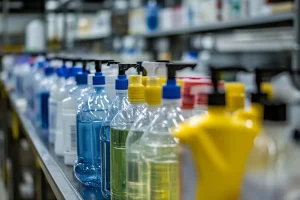 As this guide illustrates, achieving effective and safe surface disinfection is far more complex than simply spraying and wiping. It involves a nuanced understanding of:
As this guide illustrates, achieving effective and safe surface disinfection is far more complex than simply spraying and wiping. It involves a nuanced understanding of:
- The fundamental differences between cleaning, sanitizing, and disinfecting, and the appropriate application of each.
- The regulatory landscape governed by the EPA, ensuring products are tested and proven effective.
- The critical importance of meticulously following label instructions, particularly regarding pre-cleaning, dilution ratios, and, crucially, contact times.
- The diverse array of chemical disinfectant options, each with its unique efficacy spectrum, advantages, disadvantages, material compatibility issues, and safety considerations.
- The various application standards (Hospital-Grade, Food-Contact, Tuberculocidal) and specific kill claims (Bactericidal, Virucidal, Fungicidal, Sporicidal) that dictate product suitability for different environments and risks.
Navigating this complexity requires knowledge and diligence that often goes beyond typical household or untrained commercial cleaning efforts. This is where the value of professional cleaning services becomes evident.
Benefits of Hiring a Professional Cleaning Service:
- Knowledge and Training: Reputable professional services invest in training their staff on the science behind cleaning and disinfection. They understand the principles outlined in this guide and how to apply them correctly.
- Appropriate Product Selection: Professionals have access to, and knowledge of, a wider range of professional-grade disinfectants, including potentially newer, safer, or more effective formulations. Critically, they possess the expertise to select the most appropriate product based on the specific surfaces being treated, the likely pathogens of concern, the environmental context (e.g., healthcare vs. office vs. food service), and client preferences or sensitivities (e.g., requests for “green” options or low-odor products).
- Correct Application Procedures: Trained technicians ensure protocols are followed rigorously. This includes performing thorough pre-cleaning, mixing concentrates accurately (if applicable), using appropriate tools to avoid issues like quat binding, ensuring surfaces remain wet for the full required contact time, and performing post-rinsing when necessary.
- Safety and Compliance: Professionals are trained in safe chemical handling, the proper use of Personal Protective Equipment (PPE) to protect themselves and occupants, ensuring adequate ventilation, and complying with workplace safety regulations (like OSHA standards). This minimizes risks associated with chemical exposure and misuse.
- Efficiency and Effectiveness: Utilizing professional-grade equipment, proven techniques, and trained staff leads to more consistent, reliable, and efficient disinfection outcomes compared to DIY or untrained approaches.
- Peace of Mind: Entrusting disinfection tasks to knowledgeable professionals provides assurance that the job is being performed correctly, effectively, and safely. This is particularly valuable in maintaining healthy homes, productive workplaces, and safe public spaces, especially during periods of heightened health concerns.
Effective disinfection is a critical component of maintaining healthy indoor environments. By understanding the complexities involved and recognizing the benefits of professional expertise, individuals and businesses can make informed choices to protect health and well-being.
Contact us today for a consultation to discuss your specific cleaning and disinfection needs and learn how our trained professionals can provide a tailored, effective, and safe solution for your facility!




